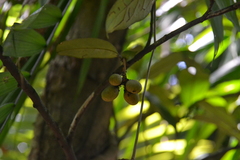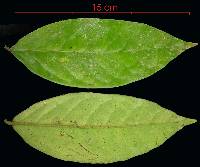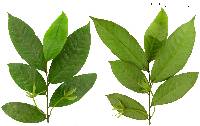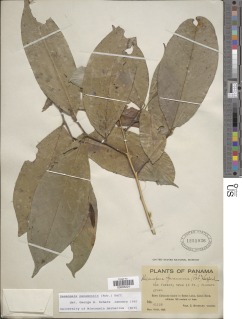

|
|
|
|
Family: Annonaceae
llayito, more...yayito
[Unona panamensis B. L. Rob.] |
Description: A small tree of the forest understory, usually less than 7 m tall, with a straight trunk. The trunk branches fairly low, and branches are straight, perpendicular to the trunk. Leaves are alternate, arranged regularly in a flat plane along branches; branch zig-zags between leaves. Leaves are oval, rounded at base and tip. The fuzzy terminal stipule usually lies pressed against the base of the last leaf on each branch. Reproduction: Flowers are greenish-white, with very narrow petals, on long stalks opposite the leaves, and are produced from January to April. The fruits are clusters of 4-8 small berries, maturing from November to March. Distribution: Abundant in the old-forest of Barro Colorado Island and in mature forests along Pipeline Rd. Less common but still numerous in the Sherman forests. Absent south of Gamboa and in wet and upper elevation forests. Never seen outside the forest. Similar Species: The regularly spaced leaves in a flat plane along a zig-zagging branch are characters of the family Annonaceae, so the best way to learn Desmopsis is to look for the terminal stipule pressed against the terminal leaf. Other differences are more subtle. The upper leaf surface of Desmopsis is smooth and shiny, with faint secondary veins, not typical of other Annonaceae such as LK guatdu Guatteria dumetorum LK2 or LK annoha Annona hayesii. LK2 LK xyl1ma (Xylopia LK2 also have shiny leaves, but they are much smaller.) Myristicaceae like LK virose Virola sebifera LK2 have leaves similar in size and arrangement to Desmopsis, but Virola leaves are bluish on the underside. Descripción: Árbol o arbusto de 3 a 10 m de alto. Tronco ramificado a baja altura. Corteza exterior negra y con manchas verdes o grises. Ramitas terminales cilíndricas y cubiertas de pelos ferruginosos. Hojas simples y alternas, de 8-25 x 3-10 cm, elípticas, con ápice agudo, bordes enteros y base obtusa o redondeada. Las hojas son glabras en el haz a excepción de la nervadura media, pero con pelos ferruginosos sobre las nervaduras del envés. Pecíolo de 0.4-0.6 cm de largo. Una característica muy sobresaliente de la especie es la forma en que la yema terminal se sobrepone en la última hoja. Flores verdes o amarillentas. Frutos en racimos de 4-8 monocarpos, de 1.5-2.5 cm de largo, verdes, tornándose rojos o morados al madurar. Semillas 2-4 en cada monocarpo, aplanadas. Datos Ecológicos: La especie crece a bajas y medianas elevaciones, en bosques húmedos o muy húmedos. En Panamá se encuentra en las provincias de Colón, Panamá y Veraguas. Común y muy abundante en el bosque viejo de la isla de Barro Colorado. Florece y fructifica durante todo el año, principalmente de abril a noviembre. Especies Parecidas: A menudo se confunde con LK unonpi Unonopsis pittieri LK2 , pero en U. pittieri los monocarpos tienen una sola semilla en forma de ‘hamburguesa’. También se puede confundir con LK des2ma Desmopsis maxonii LK2 , pero en D. maxonii las ramitas son glabras y los frutos se encuentran en grupos de 7-12 monocarpos. LK des2bi Desmopsis bibracteata LK2 es muy parecido, pero en D. bibracteata el pedúnculo de la inflorescencia es largo y sale de la axila de un par de brácteas foliares. Usos: El tronco es de diámetro pequeño y se utiliza en la fabricación de mangos de herramientas y para postes de cercas. Tree, usually 4-6 (8) m tall; young branches densely ferruginous-pubescent. Petioles to 6 mm long; blades +/- elliptic to elliptic-lanceolate, acuminate, obtuse to acute at base, 8-22 cm long, 3-10 cm wide, +/- glabrous above except on midrib, brownish-puberulent beneath, especially on veins. Flowers 1 or 2, opposite leaves, with short brownish pubescence; peduncles short with an ovate-cordate bract 4-16 mm long near apex; pedicels to 7 cm long; sepals 3, small, triangular; petals 6, +/- equal, free, at first green, becoming greenish-yellow at maturity, narrowly triangular, to 3 cm long, valvate or slightly imbricate at apex, the margins revolute, the apex curled inward; anthers many, sessile, to 1.7 mm long; carpels numerous, the styles held tightly together and exceeding anthers; ovules 2-8 per carpel. Monocarps densely short-pubescent, cylindrical, rounded on both ends, longer than broad, to 25 mm long, becoming soft and brick red at maturity on stipes to 1 cm long; seeds usually 4-6, disk-shaped. Croat 7361, 8793. Abundant in the forest, especially in the old forest. Flowers mostly during the dry season (January to April), rarely during the rainy season. Fruit maturity time uncertain, but the fruits are eaten by white-faced monkeys from October to May (J. Oppenheimer, pers. comm.). Known only from Panama, from tropical moist forest in the Canal Zone, Bocas del Toro, and Darien. |
|
|
|


















































